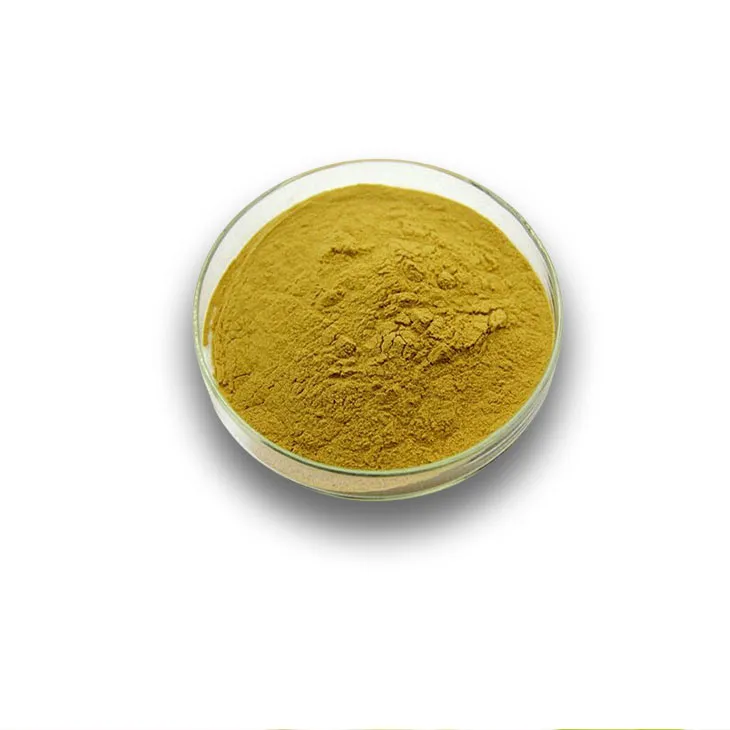- 0086-571-85302990
- sales@greenskybio.com
What is honeysuckle pollen and why is it used on the skin?
2024-11-12

1. Introduction to Honeysuckle Pollen
Honeysuckle Pollen is a fine powder that is sourced from the flowers of the honeysuckle plant. Honeysuckle is a well - known plant species, and its flowers are not only beautiful but also possess certain medicinal and beneficial properties. The pollen is a concentrated form of many of the active substances found within the honeysuckle flower.

2. Composition of Honeysuckle Pollen
Honeysuckle pollen contains a variety of components that contribute to its potential benefits for the skin. It is rich in amino acids, which are the building blocks of proteins. These amino acids play a crucial role in maintaining the structure and function of skin cells. For example, some amino acids can help in the production of collagen, a protein that is essential for skin elasticity and firmness.
It also contains vitamins, such as vitamin C and vitamin E. Vitamin C is well - known for its antioxidant properties. It can help to neutralize free radicals in the skin, which are unstable molecules that can cause damage to skin cells. Vitamin E is another powerful antioxidant that can protect the skin from oxidative stress and help in the repair of damaged skin cells.
Furthermore, honeysuckle pollen contains minerals like zinc and selenium. Zinc is involved in the regulation of skin cell metabolism and has anti - inflammatory properties. Selenium also has antioxidant effects and can contribute to the overall health of the skin.

3. Why is Honeysuckle Pollen Used on the Skin?
3.1 Moisturizing the Skin
Honeysuckle pollen has excellent moisturizing properties. The natural substances within it can penetrate deep into the skin layers. Once there, they can bind with water molecules, effectively increasing the skin's hydration level. This is important because hydrated skin looks plump and healthy.
One of the ways it moisturizes is by forming a protective layer on the skin surface. This layer acts as a barrier, preventing water from evaporating from the skin. In a way, it is like a natural moisturizer that keeps the skin from drying out. For people with dry skin, using products containing honeysuckle pollen can be a great way to improve skin hydration.
3.2 Antibacterial Effects
The antibacterial properties of honeysuckle pollen are another significant reason for its use on the skin. The skin is constantly exposed to various bacteria, and some of these can cause infections, especially when the skin barrier is compromised. Honeysuckle pollen contains substances that can inhibit the growth of bacteria.
For those with acne - prone skin, this is particularly beneficial. Acne is often caused by the overgrowth of Propionibacterium acnes, a type of bacteria that lives on the skin. Honeysuckle pollen can help to keep the population of these bacteria in check, reducing the occurrence of acne breakouts. It can also be useful in preventing other types of skin infections, such as folliculitis, which is an infection of the hair follicles.
3.3 Promoting Skin Cell Regeneration
Honeysuckle pollen may play a role in promoting skin cell regeneration. The nutrients it contains, such as amino acids and vitamins, can stimulate the division and growth of skin cells. This is crucial for maintaining healthy skin, as skin cells are constantly being shed and replaced.
When skin cells regenerate more efficiently, it can lead to a reduction in the appearance of fine lines and wrinkles. The skin looks more youthful and smooth. Additionally, for those with damaged skin, such as from minor cuts or burns, the promotion of skin cell regeneration can help in the healing process.

4. How to Use Honeysuckle Pollen on the Skin
There are several ways to use honeysuckle pollen on the skin. One common method is through the use of skincare products that contain honeysuckle pollen as an ingredient. These products can include creams, lotions, and serums.
- Creams: Honeysuckle pollen - infused creams are often thicker in consistency. They are suitable for those with dry or normal skin types. The cream can be applied to the face and body, usually in the morning and evening after cleansing the skin.
- Lotions: Lotions with honeysuckle pollen are lighter and more easily absorbed by the skin. They are a good option for those who prefer a lighter texture, especially for use during the day or in warmer weather.
- Serums: Serums containing honeysuckle pollen are highly concentrated formulations. They are designed to penetrate deep into the skin and deliver a high dose of the beneficial ingredients. Serums are typically used before applying creams or lotions.
Another way to use honeysuckle pollen on the skin is by making a homemade mask. Here is a simple recipe:
- Mix a small amount of honeysuckle pollen with some honey and a little bit of plain yogurt.
- Apply the mixture evenly to the face, avoiding the eye area.
- Leave the mask on for about 15 - 20 minutes.
- Rinse off with warm water and pat the skin dry.

5. Precautions When Using Honeysuckle Pollen on the Skin
While honeysuckle pollen has many potential benefits for the skin, there are also some precautions to keep in mind.
- Allergic Reactions: Some people may be allergic to honeysuckle pollen. Before using any product containing it, it is advisable to do a patch test on a small area of skin, such as the inner forearm. Wait for 24 - 48 hours to see if there is any redness, itching, or swelling. If there are any signs of an allergic reaction, do not use the product.
- Quality and Source: Ensure that the honeysuckle pollen used in skincare products is of high quality and from a reliable source. Poor - quality pollen may not have the same beneficial effects and may even contain contaminants.
- Interaction with Other Ingredients: If using skincare products that contain multiple ingredients along with honeysuckle pollen, be aware of potential interactions. Some ingredients may interfere with the effectiveness of the honeysuckle pollen or cause adverse reactions.
6. Conclusion
Honeysuckle pollen is a natural substance with great potential for skin health. Its composition, which includes amino acids, vitamins, and minerals, gives it the ability to moisturize the skin, fight bacteria, and promote skin cell regeneration. However, when using it on the skin, it is important to be aware of precautions such as allergic reactions, quality of the pollen, and potential ingredient interactions. By using honeysuckle pollen in a proper and informed way, it can be a valuable addition to a skincare routine, helping to achieve healthier, more beautiful skin.
FAQ:
1. How can honeysuckle pollen be collected for skin use?
Collecting honeysuckle pollen for skin use should be done carefully. Firstly, ensure that the honeysuckle is from a non - polluted source. One can use a small brush or a specialized pollen - collecting tool. Gently brush the stamens of the honeysuckle flowers to collect the pollen. However, it is important to note that in some areas, wild honeysuckle may be protected, so it is advisable to use commercially available honeysuckle pollen products that are processed in a proper and safe way.
2. Are there any side effects of using honeysuckle pollen on the skin?
Although honeysuckle pollen has many benefits for the skin, there may be some potential side effects. Some people may be allergic to it. Skin allergic reactions may include redness, itching, and swelling. Before using it on a large area of the skin, it is recommended to do a patch test on a small area of the skin, such as the inner forearm. If any abnormal reactions occur within 24 - 48 hours, stop using it immediately.
3. How long does it take to see the effects of using honeysuckle pollen on the skin?
The time it takes to see the effects of using honeysuckle pollen on the skin can vary from person to person. Generally, if the main purpose is moisturizing, some people may notice a slight improvement in skin hydration within a few days. For antibacterial effects on acne - prone skin, it may take about a week or two to start seeing a reduction in inflammation. And for promoting skin cell regeneration to make the skin look more youthful, it may take several weeks to months of continuous use to see more obvious results.
4. Can honeysuckle pollen be used on all skin types?
Honeysuckle pollen can be used on most skin types. For dry skin, its moisturizing properties are very beneficial. For oily and acne - prone skin, its antibacterial properties can help control sebum production and prevent acne. However, for those with extremely sensitive skin, extra caution is needed due to the potential for allergic reactions. As mentioned before, a patch test is essential for sensitive - skin individuals.
5. How should honeysuckle pollen be stored for skin use?
Honeysuckle pollen for skin use should be stored in a cool, dry, and dark place. It is best to keep it in an airtight container to prevent moisture absorption and oxidation. If it is a commercial product, follow the storage instructions on the packaging. Generally, if stored properly, it can maintain its effectiveness for a certain period, but it is also recommended to use it within a reasonable time frame to ensure the best quality.
Related literature
- The Nutritional and Medicinal Properties of Honeysuckle Pollen"
- "Honeysuckle Pollen: A Natural Ingredient for Skin Health"
- "Beneficial Effects of Honeysuckle - derived Substances on the Skin"
- ▶ Hesperidin
- ▶ citrus bioflavonoids
- ▶ plant extract
- ▶ lycopene
- ▶ Diosmin
- ▶ Grape seed extract
- ▶ Sea buckthorn Juice Powder
- ▶ Beetroot powder
- ▶ Hops Extract
- ▶ Artichoke Extract
- ▶ Reishi mushroom extract
- ▶ Astaxanthin
- ▶ Green Tea Extract
- ▶ Curcumin Extract
- ▶ Horse Chestnut Extract
- ▶ Other Problems
- ▶ Boswellia Serrata Extract
- ▶ Resveratrol Extract
- ▶ Marigold Extract
- ▶ Grape Leaf Extract
- ▶ blog3
-
Cranberry Plants and Skin - care Products.
2024-11-12
-
Black Rice Extract
2024-11-12
-
Nettle leaf extract
2024-11-12
-
Yohimbine Bark Extract
2024-11-12
-
Mulberry leaf Extract
2024-11-12
-
Pomegranate Extract
2024-11-12
-
Lemon Balm Extract
2024-11-12
-
Mangosteen extract powder
2024-11-12
-
Medicinal Marshmallow Extract
2024-11-12
-
Oat Straw Extract Powder
2024-11-12
-
Quercetin
2024-11-12





















